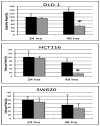Slug expression inhibits calcitriol-mediated sensitivity to radiation in colorectal cancer
- PMID: 23996472
- PMCID: PMC3858479
- DOI: 10.1002/mc.22054
Slug expression inhibits calcitriol-mediated sensitivity to radiation in colorectal cancer
Abstract
Recently, a reciprocal relationship between calcitriol and epithelial-to-mesenchymal transition has been described. Therefore, we hypothesized that calcitriol (1α,25-dihydroxyvitamin D₃) would enhance radiation sensitivity in colorectal cancer regulated by epithelial mesenchymal transition. Vitamin-D receptor, E-cadherin and vimentin protein as well as E-cadherin, Snail and Slug mRNA levels were assessed in a panel of human colorectal cancer cell lines at baseline and in response calcitriol. We defined cell lines as calcitriol sensitive based on demonstrating an enhanced epithelial phenotype with increased E-cadherin, reduced vimentin and decreased expression of Snail and Slug as well as decreased cellular migration in response to calcitriol. In calcitriol sensitive cells, including DLD-1 and HCT116, 24 h calcitriol pre-treatment enhanced the radiation sensitivity by 2.3- and 2.6-fold, respectively, at 4 Gy (P < 0.05). In contrast, SW620 cells with high baseline mesenchymal features including high Slug and vimentin expression with low E-cadherin expression demonstrated no significant radiation sensitizing response to calcitriol treatment. Similarly, transfection of Slug in the calcitriol sensitive colon cancer cell lines, DLD-1 and HCT 116, completely inhibited the radiation sensitizing effect of calcitriol. Collectively, we demonstrate that calcitriol can enhance the therapeutic effects of radiation in colon cancer cells and Slug expression mitigates this observed effect potentially representing an effective biomarker for calcitriol therapy.
Keywords: EMT; Slug; cancer; colorectal; radiation; vitamin D.
© 2013 Wiley Periodicals, Inc.
Figures







Similar articles
-
Vitamin D regulating TGF-β induced epithelial-mesenchymal transition.Respir Res. 2014 Nov 21;15(1):146. doi: 10.1186/s12931-014-0146-6. Respir Res. 2014. PMID: 25413472 Free PMC article.
-
Increased expression of Slug and Vimentin as novel predictive biomarkers for lymph node metastasis and poor prognosis in colorectal cancer.Carcinogenesis. 2013 Nov;34(11):2548-57. doi: 10.1093/carcin/bgt282. Epub 2013 Sep 3. Carcinogenesis. 2013. PMID: 24001454
-
Snail2 cooperates with Snail1 in the repression of vitamin D receptor in colon cancer.Carcinogenesis. 2009 Aug;30(8):1459-68. doi: 10.1093/carcin/bgp140. Epub 2009 Jun 5. Carcinogenesis. 2009. PMID: 19502595
-
The prognostic and therapeutic potential of vimentin in colorectal cancer.Mol Biol Rep. 2024 Sep 30;51(1):1027. doi: 10.1007/s11033-024-09965-w. Mol Biol Rep. 2024. PMID: 39347868 Review.
-
SNAIL vs vitamin D receptor expression in colon cancer: therapeutics implications.Br J Cancer. 2005 Mar 28;92(6):985-9. doi: 10.1038/sj.bjc.6602484. Br J Cancer. 2005. PMID: 15770204 Free PMC article. Review.
Cited by
-
Role of Vitamin D in Head and Neck Cancer-Immune Function, Anti-Tumour Effect, and Its Impact on Patient Prognosis.Nutrients. 2023 May 31;15(11):2592. doi: 10.3390/nu15112592. Nutrients. 2023. PMID: 37299554 Free PMC article. Review.
-
Immune Response: A Missed Opportunity Between Vitamin D and Radiotherapy.Front Cell Dev Biol. 2021 Apr 13;9:646981. doi: 10.3389/fcell.2021.646981. eCollection 2021. Front Cell Dev Biol. 2021. PMID: 33928081 Free PMC article. Review.
-
Vitamin D, gut microbiota, and radiation-related resistance: a love-hate triangle.J Exp Clin Cancer Res. 2019 Dec 16;38(1):493. doi: 10.1186/s13046-019-1499-y. J Exp Clin Cancer Res. 2019. PMID: 31843023 Free PMC article. Review.
-
Slug inhibition increases radiosensitivity of nasopharyngeal carcinoma cell line C666-1.Exp Ther Med. 2018 Apr;15(4):3477-3482. doi: 10.3892/etm.2018.5844. Epub 2018 Feb 7. Exp Ther Med. 2018. PMID: 29545871 Free PMC article.
-
Vitamin D and the Epithelial to Mesenchymal Transition.Stem Cells Int. 2016;2016:6213872. doi: 10.1155/2016/6213872. Epub 2016 Jan 6. Stem Cells Int. 2016. PMID: 26880977 Free PMC article. Review.
References
-
- Sauer R, Becker H, Hohenberger W, et al. Preoperative versus postoperative chemoradiotherapy for rectal cancer. N Engl J Med. 2004;351:1731–1740. - PubMed
-
- Deeb KK, Trump DL, Johnson CS. Vitamin D signalling pathways in cancer potential for anticancer therapeutics. Nat Rev Cancer. 2007;7:684–700. - PubMed
Publication types
MeSH terms
Substances
Grants and funding
LinkOut - more resources
Full Text Sources
Other Literature Sources
Medical
Research Materials
Miscellaneous

